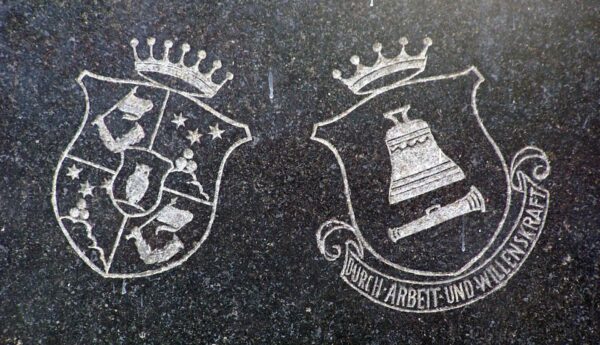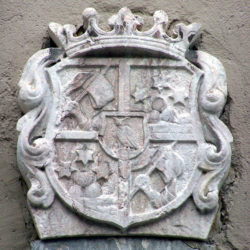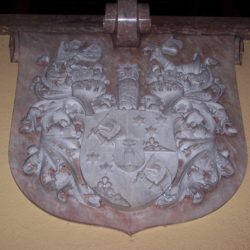
Arms of alliance of the Codelli and Samassa families in Višnja Gora
VIšNJA GORA, ST. GILES' CHURCH
Location of the coat of arms: tombstone
The wall of St. Giles’ Church in Višnja Gora features a built-in tombstone with the only (known) depiction of the coat of arms of the Samassa family. It is the tombstone of Baroness Miriam von Codelli (1874–1935), the famous inventor Anton Codelli’s older sister, who remarried Max (Sln. Maks) Samassa (1862–1945). She died in September 1935 and was buried in Višnja Gora because the Barons Codelli owned (the now ruined) Višnje or Turn Castle in Peščenik.
Miriam’s husband Max Samassa descended from the famous family of bellmakers that moved from the northern part of the Province of Venice to Ljubljana in the early eighteenth century. There, they founded a family business which, apart from the bell foundry, also comprised other activities such as the production of fire hoses and cannon casting. Under Albert Samassa (1833–1917), the family enterprise also began to engage in bronze casting, and it established collaboration with shipbuilding companies and the navy. In Albert’s time, the foundry, primarily situated on Karlovška Road in Ljubljana, expanded to modern Zvonarska Street and part of what is now Ljubljana’s district of Prule. Between 1869 and 1871, Albert Samassa built a villa in the location of the old house on Karlovška Road 1. The villa still stands today. During the heightened national tensions in the second half of the nineteenth century, he came under a barrage of criticism from Slovenian opponents for siding squarely with the Germans. In 1900, Albert withdrew from public life and handed over the reins of his enterprise to his son Max.
The end of the First World War and the disintegration of the monarchy also spelled an end to the Samassa family business. It came to Max’s knowledge that a diocesan bell foundry was about to open in Ljubljana, recruiting his employees, in addition to which his arrangement with the navy fell through after Trieste, Pula, and Rijeka passed into the Italian hands. Therefore, he decided to sell his enterprise to Jadranska Banka (Adriatic Bank) and the new joint-stock company Strojne tovarne in livarne (Machinery Shops and Iron Foundries), the predecessor of the Slovenian heavy machinery manufacturer Litostroj. Withdrawing from Slovenian territory, Max Samassa first settled in Wiener Neustadt and then in Vienna, where he died immediately after the end of the Second World War, in June 1945. According to his relatives, he died tragically of hunger.
In 1918, on the eve of the monarchy’s disintegration, the Samassa family was awarded a special honor—the title of nobility—very likely to commemorate the 150th anniversary of its enterprise, which was marked in 1917 (although the official year of its founding was 1767, the family had already run its operations in Ljubljana before that). On ennoblement, Max Samassa requested the predicate Hüttenstaet to represent his profession (Hütte = metallurgical works). For his coat of arms, he selected the depiction of a church bell and a cannon tube on the ground that his family had used such a coat of arms from the mid-eighteenth century onward. Samassa’s coat of arms also incorporated the motto Durch Arbeit und Willenskraft (With hard work and willpower).
Since 1792, the Samassa family had a relatively modest tomb in what was once Ljubljana’s central Saint Christopher’s Cemetery. The tomb was preserved until 1938, when it was demolished along with the old city cemetery. The only vestiges of the Samassa family in modern Ljubljana are the villa on Karlovška Road above the tunnel entrance and Zvonarska (Bellfounder’s) Street, named after their longstanding and principal business activity—bell foundry.
Sources:
Rugále, Mariano in Preinfalk, Miha: Blagoslovljeni in prekleti. 2. del: Po sledeh mlajših plemiških rodbine na Slovenskem. Ljubljana: Viharnik, 2012, pp. 189–192.





